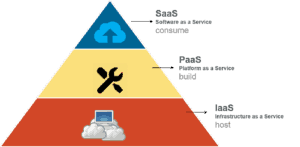What Does it Mean to Be a “Cloud Computing Company” in 2019?
Connectria
Author
Date
August 8, 2019

If you were to do an internet search for “cloud computing company,” there would be hundreds of companies that would appear—and their offerings would cover a vast array of products and services. This is beginning to lead to some confusion in the market.
It’s the tech equivalent of lumping together architectural firms, construction companies, lumber yards, and real estate companies and calling them all “companies that do buildings.” While that’s roughly true, each is offering a very different sort of thing.
So what exactly does it mean to be a cloud computing company in 2019? And what sort of cloud computing company does your organization actually need to assist with its digital transformation?
Cloud Computing: Simple Concept, Complex Execution
The definition of the term cloud computing is straightforward: It is a type of computing that relies on shared computing resources, often in large centralized data-centers rather than on-premises servers or personal devices. Cloud computing today often manifests as applications, storage, and other services that are hosted off-site and accessed via a web browser, app, or dashboard.
Because there are no on-premises machines, there are no up-front capital costs for the technology; indeed, many businesses offer a pay-as-you-go model that can scale with the organization’s specific needs.
Although the term has a simple, straightforward definition, there are many different ways of realizing this definition. This has led to a layered concept of the cloud, with specific services and applications at the top and virtual infrastructure at the bottom.
Types of Cloud Computing Companies—The Traditional Layers Model
Most cloud companies are what we would call cloud service providers. These companies offer pay-as-you-go services for one or more layers of the cloud. Here are how the layers are divided:

Software as a Service (SaaS)
SaaS companies create applications that are hosted in the cloud. Instead of paying a one-time fee for a piece of software (downloaded or possibly even on a CD), users create an online account and access the software via the web. Google Docs, Salesforce, and MavenLink are good examples.
Cloud storage products are one subset of SaaS products. These offer users virtual storage space and the ability to share or provide access to files. Dropbox, Google Drive, iCloud Drive, and Microsoft’s OneDrive are all examples of cloud storage products.
Platform as a Service (PaaS)
Companies that offer PaaS provide software tools and hardware over the internet (most often for application development). Thus, the organization provides and manages the applications and data, while all of the supporting software and hardware is managed by the third-party PaaS provider. Good examples include AWS Elastic Beanstalk, Windows Azure (when used as PaaS), App Engine, and so on.
Infrastructure as a Service (IaaS)
IaaS is an alternative to maintaining on-premises hardware. IaaS companies offer pay-as-you-go resources for storage, networking, and computing. Unless other services are contracted for, the client is responsible for management and security, but they also have control over the environment, as we’ll discuss in a moment. Amazon EC2, Microsoft Azure, Google Cloud Platform (GCP), and Connectria’s private, hosted clouds are prime examples of IaaS.
IaaS is the level at which cloud-computing companies make a distinction between public, private, and hybrid clouds. Amazon AWS, Microsoft Azure, and Google Cloud Services are all examples of public clouds, where resources are shared among the various users. With our private, hosted cloud, Connectria hosts dedicated client resources in one of our SOC 2 certified data centers. A hybrid cloud, such as Connectria’s IBM Cloud with AWS and Azure, combines multiple cloud environments.
The distinctions between SaaS, PaaS, and IaaS have been around in the industry for some time. However, today they capture only a fraction of the companies providing cloud products.
Other Kinds of Cloud Services
Outside of the traditional 3-layer model of the cloud, there are a number of services that are offered today, many of which complement the kinds of products and services mentioned above:
- Cloud back-up and DR – Disaster recovery includes not only the back-up of data but replication of computer resources so that, if the system becomes unavailable, the mirror copy can seamlessly take over the workloads.
- Cloud monitoring – Most cloud services, especially at the PaaS and IaaS level, offer their own monitoring tools. But these tools vary in quality, ease of use, and overall visibility into the cloud. Even when cloud monitoring tools are ideal, they are limited to a specific vendor, meaning multiple tools for multiple clouds. Enter cloud monitoring services. Cloud monitoring is offered by third-party companies who specialize in monitoring dashboards and offer their services to give companies better insight into their cloud usage and resources.
- Cloud management – Mismanagement of cloud resources can be incredibly costly, and the chances of a problem are only compounded when an organization starts using multiple clouds. New tools (like Connectria’s own TRiA) have sprung up to ensure security and compliance, optimize cloud spend, improve governance and visibility, and more. Modern cloud management platforms often provide for DR and monitoring, too. (Some writers use “cloud monitoring” and “cloud management” interchangeably. Here we’ve assumed that monitoring is just one subset of tasks that a management platform does.)
- Analytics as a Service (AaaS) – AaaS is much like SaaS, but the tools offered are tightly integrated with another service or platform so that data can be gathered and analyzed. This is becoming more prominent in the industry as companies move toward realizing IoT and are generating huge amounts of valuable data.
Which Type of Cloud Company Does Your Organization Need to Engage?
This is a great question…and a tricky one. Some organizations will be happy finding a specific SaaS offering to solve a specific problem—for example, Salesforce—and then learning how to integrate that solution with their existing databases and architecture. Others will seek to shift their computing workloads to a public cloud to allow for better scalability and cost control.
In other words, which cloud company your organization will need depends on your specific goals, as well as your current IT configuration. Both will likely change as your organization gets further along in its cloud journey. Ironically, it might be best to start with a company that offers cloud management and/or cloud management tools, and that is agnostic when it comes to cloud providers. (Cards on the table: We consider ourselves to be such a company!)
This approach makes sense when one pauses to consider it. A cloud management company often has the best information on multiple cloud vendors and can provide an objective comparison of them. They can help with setup and migration and offer tools for monitoring and cost control. And, best of all, you don’t get locked into a single cloud platform from the get-go.
Contact Connectria if this sounds like an appealing way to start or if you other cloud questions!
Keep Reading
Prepare for the future
Tell us about your current environment and we’ll show you the best path forward.
Fast track your project. Give us a call.





